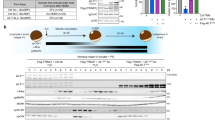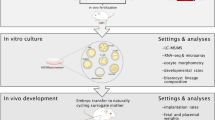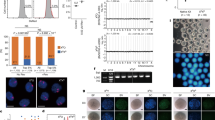Abstract
INVESTIGATIONS of the breeding performance and early embryo-genesis of the XO female mouse1,2 by Cattanach3 and Morris4 were difficult to explain because the number of XO females born to XO mothers was considerably less than predicted. Cattanach3 suggested there was either a preferential loss of the chromosome sets lacking an X to the polar bodies during meiosis, or death during early embryonic development. Morris4 and others5,6 concluded that YO was inviable. The proportion of oocytes with and without an X chromosome was determined at metaphase II. The sex-linked Tabby gene was used as a marker in the XO mice, which were of similar stock to those used by Cattanach3 and Morris4. XO females in succeeding generations were mated to +/y and Ta/y males. Ta/O females were superovulated and autopsied 16–20 h after the human chorionic gonadotrophin (HCG) injection. The freshly ovulated oocytes were liberated from the ampullae and ovarian oocytes from the larger intact follicles. Oocytes at the germinal vesicle stage were cultured for 18–24 h in modified Krebs-Ringer bicarbonate medium7, after which most reached metaphase II. The metaphase II cells were placed in 1% sodium citrate solution for 10–20 min. Air-dried preparations were made by the method described by Tarkowski8 and stained with 2% Giemsa at pH 7.0 for 45 min. The slides were washed briefly with distilled water, allowed to dry and then dehydrated with xylol and mounted with ‘Clearmount’.
This is a preview of subscription content, access via your institution
Access options
Subscribe to this journal
Receive 51 print issues and online access
$199.00 per year
only $3.90 per issue
Buy this article
- Purchase on SpringerLink
- Instant access to full article PDF
Prices may be subject to local taxes which are calculated during checkout
Similar content being viewed by others
References
Russell, W. L., Russell, L. B., and Gower, J. S., Proc. US Nat. Acad. Sci., 45, 554 (1959).
Welshons, W. J., and Russell, L. D., Proc. US Nat. Acad. Sci., 45, 560 (1959).
Cattanach, B. M., Genet. Res., 3, 487 (1962).
Morris, T., Genet. Res., 12, 125 (1968).
Ohno, S., Sex Chromosomes and Sex-linked Genes (Springer-Verlag, Berlin, Heidelberg, New York, 1967).
Lyon, M. F., Phil. Trans. Roy. Soc., B, 259, 41 (1970).
Whittingham, D. G., J. Reprod. Fert. Suppl., 14, 7 (1971).
Tarkowski, A. K., Cytogenetics, 5, 394 (1966).
Zimmering, S., Sandler, L., and Nicoletti, B., Ann. Rev. Genet., 4, 409 (1970).
Rhoades, M. M., Genetics, Princeton, 27, 395 (1942).
Battaglia, E., Caryologia, 17, 245 (1964).
Seiller, J., Arch. Zellforsch., 15, 249 (1921).
Wallace, M. E., Phil. Trans. Roy. Soc., B, 241, 211 (1958).
Author information
Authors and Affiliations
Rights and permissions
About this article
Cite this article
KAUFMAN, M. Non-Random Segregation during Mammalian Oogenesis. Nature 238, 465–466 (1972). https://doi.org/10.1038/238465a0
Received:
Issue date:
DOI: https://doi.org/10.1038/238465a0
This article is cited by
-
Meiotic drive in female mice: an essay
Mammalian Genome (1995)
-
Increased incidence of unpartnered single chromatids in metaphase II oocytes in 39,X(XO) mice
Experientia (1994)
-
Some characteristics of the XO mouse (Mus musculus L.) II. Reproduction: fertility and gametic segregation
Genetica (1981)



